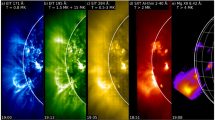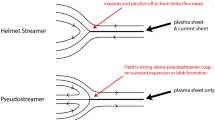Abstract
This study reveals a new feature of many solar jets: a group height, which links their acceleration and velocity.
The acceleration and velocity (\(a\), \(V\)) for jets such as spicules, often displayed as scattergraphs, show a strong correlation. This can be represented empirically by the equation, \(V = pa + q\), where \(p\) and \(q \) are two arbitrary non-zero constants.
This study reanalyses the (\(a\), \(V\)) data for nine different groups of jets, in order to test an alternative proposal that a simpler relationship directly links (\(a\), \(V\)) to the mean height for the group of jets, without needing the empirical constants \(p \) and \(q\). A standard mathematical test – plotting log(\(a\)) against log(\(V\)), tests whether \(V\ \sim \ a^{n}\) and if so, gives the value of n. When this is done for a wide range of jets the index \(n\) is consistently found to be close to 0.5
The nine groups of jets include spicules, macrospicules and dynamic fibrils. The result, \(V\ \sim \ a\)0.5, or equivalently \(V^{2} = ka\), with only one constant, provides as close a match to the data as the equation \(V = pa + q\), which requires two unknown constants. It is found that the constant \(k\), is a known quantity: just twice the mean height, \(\overline{s}\), of the group of jets being analysed. This then gives the equation \(V^{2} =2\ a\ \overline{s}\), for the jets in the group. This more succinct relationship links the acceleration and maximum velocity of every jet in the group to a well-defined quantity – the mean height of the group of spicules, without needing extra constants






Similar content being viewed by others
Data Availability
The data underlying this article will be shared on reasonable request to the corresponding author.
References
Anan, T., Kitai, R., Kawate, T., Matsumoto, T., Ichimoto, K., Shibata, K., Hillier, A., Otsuji, K., Watanabe, H., Ueno, S., Nagata, S., Ishii, T.T., Komori, H., Nishida, K., Nakamura, T., Isobe, H., Hagino, M.: Astron. Soc. Jpn. 62, 871 (2010)
De Pontieu, B., et al.: Publ. Astron. Soc. Jpn. 59(SP3), s655–s662 (2007)
De Pontieu, B., Hansteen, V., Rouppe van der Voort, L., et al.: In: Heinzel, P., Dorotovic, I., Rutten, R.J. (eds.) Coimbra Solar Physics Meeting on the Physics of Chromospheric Plasmas. ASP Conference Series, vol. 354 (2007b). arXiv:astro-ph/0702081
De Pontieu, B., Hansteen, V.H., Rouppe van der Voort, L., van Noort, M., Carlsson, M.: Astrophys. J. 655, 624 (2007a)
Duan, Y., Shen, Y., Chen, H., Tang, Z., Zhou, C., Zhou, X., Tan, S.: Astrophys. J. Lett. 942(L22), 2 (2023)
Freeman, L.: Mon. Not. R. Astron. Soc. 489, 3 (2019). https://doi.org/10.1093/mnras/stz2402j10
Heggland, L., De Pontieu, B., Hansteen, V.H.: Astrophys. J. 666, 1277 (2007)
Kuridze, D., Uitenbroek, H., Wöger, F., et al.: Astrophys. J. 965, 15 (2024)
Lippincott, S.L.: Chromospheric Spicules. Smithson. Contrib. Astrophys. 2, 15 (1957)
Loboda, I.P., Bogachev, S.A.: A&A V 597, A78 (2017)
Loboda, I.P., Bogachev, S.A.: (2019). arXiv:1902.01380v1
McIntosh, S.W., De Pontieu, B., Tarbell, T.D.: Astrophys. J. 673, L219 (2008)
Pereira, T.M.D., De Pontieu, B., Carlsson, M.: Astrophys. J. 759, 18 (2012)
Rouppe van der Voort, L.H.M., De Pontieu, B., Hansteen, V.H., Carlsson, M., van Noort, M.: Astrophys. J. 660, L169–L172 (2007)
Rouppe van der Voort, L.H.M., de la Cruz Rodrıguez, J.: Astrophys. J. Lett. 776, 56 (2013)
Schad, T.A., Penn, M.J., Lin, H.: Astrophys. J. 768, 111 (2013)
Skogsrud, H., Rouppe van der Voort, L., De Pontieu, B.: Astrophys. J. Lett. 795, L23 (2014)
Tian, H., DeLuca, E., Reeves, K.K., et al.: Astrophys. J. 786, 137 (2014)
Tsiropoula, G., Tziotziou, K., Kontogiannis, I., Madjarska, M.S., Doyle, J.G., Suematsu, Y.: SSR 169, 181 (2012)
Zhang, Y.Z., Shibata, K., Wang, J.X., Mao, X.J., Matsumoto, T., Liu, Y., Su, J.T.: Astrophys. J. 750, 1 (2012)
Zhang, J., Tian, H., He, J., et al.: Astrophys. J. 838, 2 (2017). https://doi.org/10.3847/1538-57/aa63e8
Author information
Authors and Affiliations
Contributions
I am the sole author and creator of this work.
Corresponding author
Ethics declarations
Competing interests
The authors declare no competing interests.
Additional information
Publisher’s Note
Springer Nature remains neutral with regard to jurisdictional claims in published maps and institutional affiliations.
Rights and permissions
Springer Nature or its licensor (e.g. a society or other partner) holds exclusive rights to this article under a publishing agreement with the author(s) or other rightsholder(s); author self-archiving of the accepted manuscript version of this article is solely governed by the terms of such publishing agreement and applicable law.
About this article
Cite this article
Freeman, L.A. The group height of spicules links their acceleration and velocity. Astrophys Space Sci 369, 47 (2024). https://doi.org/10.1007/s10509-024-04308-4
Received:
Accepted:
Published:
DOI: https://doi.org/10.1007/s10509-024-04308-4




